This summer, the best strategy for the court? Play it safe! Stay hydrated and use good form. If an injury does happen, be sure to contact us. Regenerative solutions will help you recover quickly, repair injured tissue, and get back to the fun.
In this article, we cover the benefits and potential dangers of pickleball and suggest some important and proactive steps to protect against possible injuries like knee sprains and strains, torn rotator cuffs, and ‘pickleball elbow.’
Pickleball 101
Super popular, fun, and social, Pickleball is the quickest growing sport in America.1 Designed (in 1965) for people of all ages to play, it takes only about 15 minutes for a game, and is a great low-impact cardiovascular exercise.
While not as strenuous as tennis or jogging, pickleball requires you to stay alert, promotes visual acuity, and can improve cognition as you strategize.
Who’s playing? Well, according to The Pickleball Player, 61% of players are men and 39% are women.
And because it’s not necessary to run too much to play, seniors are flocking to the game. Of America’s serious pickleball players, defined as those who play at least 8 times a year, 52% are over 55 years of age and 32.7% are 65 years or older.
The average pickleball player’s age is 38. Compared to 41 years in 20202, it’s clear pickleball is gaining popularity among the younger set. Yet, studies show that few injuries are sustained by players under the age of 50, and injury rates increase markedly each decade – with 81.4% of pickleball injuries occurring in players over the age of 60.3
Since our bodies’ ability to recover quickly from injury diminishes as we age, it’s good practice for anyone interested in playing pickleball to learn and know how to:
- Prepare your body for the demands of the game.
- Learn proper form to guard against possible injury.
- Take important steps to improve your overall energy, flexibility, and vitality.
In this article, we’ll help you learn which injuries to look out for and easy ways to protect against injury.
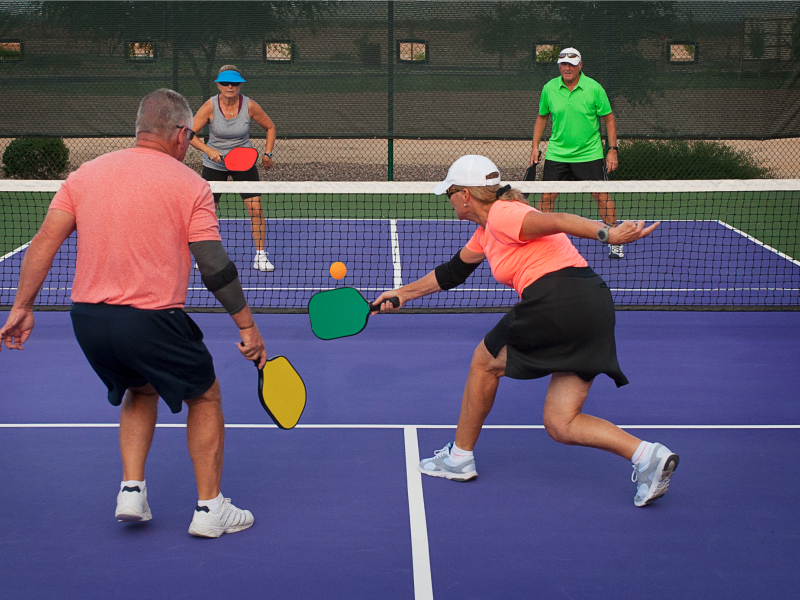
Pickleball is played on an indoor or outdoor surface slightly smaller than a tennis court, can be played as singles or doubles, and combines elements from tennis, badminton, and ping pong. To find a local Portland pickleball court, visit Pickleheads.
The most common type of pickleball injuries are:
Overuse Injuries – Many older players are retired and may play pickleball for hours at a time, which turns this low-impact cardiovascular workout into a pathway to repetitive stress injuries. For example: tennis elbow (inflamed tendons); knee strain, or Achilles tendinitis. These types of injuries can severely limit your day-to-day activities.
For instance, pain from “pickleball elbow” (lateral epicondylitis) can travel into the forearm and wrist, generating pain that can make it hard to shake hands, grip an object, turn a doorknob, or even hold a coffee cup.4 Additionally, “pickleball wrist” is a form of wrist tendinitis caused by overextension or repetitive use.
Exacerbation of pre-existing conditions – You may already have some arthritis in your knee or hip or shoulder and not be experiencing much pain. Yet, you discover after playing a few rounds of pickleball that you wake up the next day with so much pain and soreness that walking is difficult, or you don’t have the same range of motion and flexibility as before.
The pain may go away with rest and hot/cold therapy, but injury or trauma to joints can worsen osteoarthritis symptoms. Also, I like to caution my older patients that joint injuries can result from over-exercising the joint, repetitive motions, or from a fall or knock to the joint. Furthermore, osteoarthritis flare-ups can occur when injuries damage the cartilage, bone, or both.5
Acute injuries – Specific incidents on the court, like a trip or a fall, can cause you to twist your knee, hurt your back, or break a wrist. Other forms of acute injury are sprains, strains, and fractures. There have even been retinol injuries from the ball hitting a player in the eye.6 Since most players don’t wear eye protection, like in racquetball or squash, eye injury really is a potential concern.
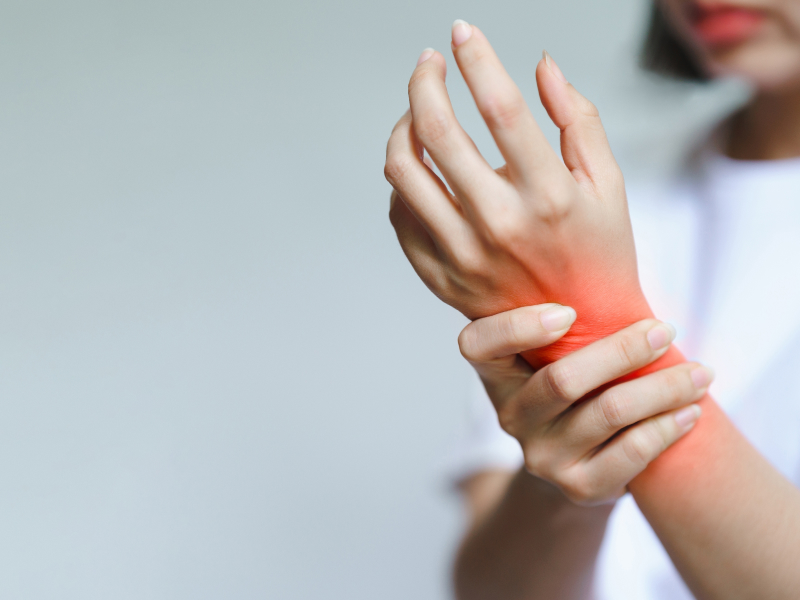
According to a recent Forrester report7, among seniors, the most common pickleball-related injuries were strains and sprains (33.2%), fractures (28.1%), and contusions (10.6%).
Per a recent report, senior men were more likely than senior women to suffer a pickleball-related strain or sprain, while women were more likely to sustain a fracture. In fact, senior women were 9x more likely than senior men to fracture a wrist while playing pickleball. Note that the wrist is particularly vulnerable in pickleball because service requires considerable wrist action; and players instinctively use their hands to break a fall, which can put wrists in danger.
Chronic injuries – The most common chronic injuries pickleball players get include plantar fasciitis and contusions of the heel from repetitive pounding on hard courts. If not promptly and properly treated, an acute injury due to overextension could become chronic. Though rotator cuff injury can occur in people who do not play any sports at all, frequent pickleball play can accelerate chronic rotator cuff pain, even for players who use good form. Shoulder-strengthening exercises can help minimize the risk of rotator cuff tears and icing shoulders after play is a good preventive measure.
5 Important Ways to Prevent Pickleball Injury
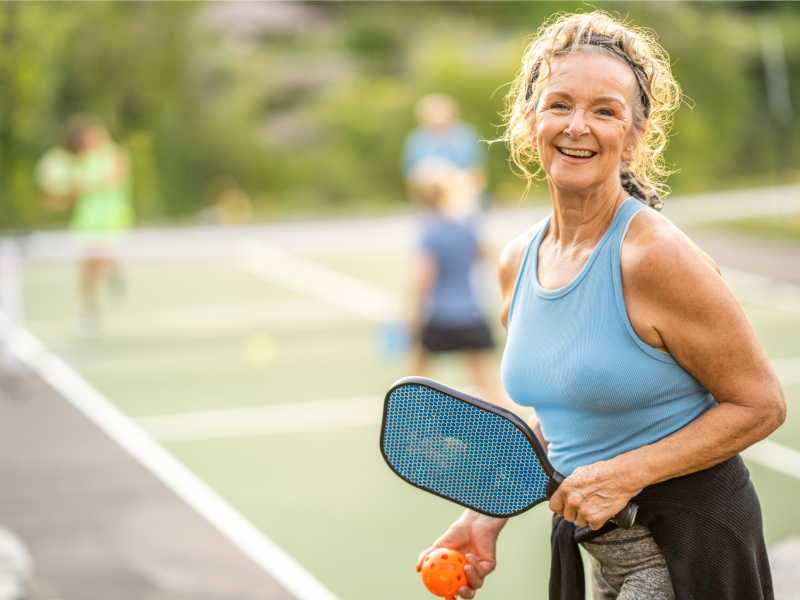
Before you start any new sport. I always recommend checking with your physician – especially if you have an underlying condition. Because pickleball is social and accessible, many new players may approach it with a “weekend warrior” attitude – where they go full-tilt without the proper preparation or recovery procedures.
We physicians can help temper your experience and suggest ways to proactively prepare. Here are my top five suggestions for protecting your health to ensure you have fun on the pickleball court instead of putting yourself in situations that can become hazardous to your health.
1. Stretch – Learn which stretches are best and when to do them.
Anyone who’s new to regular athletic activity needs to learn the basics of sports safety, which include being conscientious about stretching and warming up.
Overall, in America, 46% of senior citizens participate in no leisure aerobic activities of any kind and only 26% say they’re regularly active.8 So, remember you can’t just bound out onto the court; you must always stretch first. From my perspective, there are two types of stretching: dynamic and static. You’ll want to do 5-10 minutes of dynamic stretching before you ever step onto the court and follow up with static stretching after your pickleball session.

Dynamic Stretches: Doctors used to recommend static stretches before exercise. But boat loads of research proves dynamic stretches are better for performance and safety. Try this dynamic warm-up designed by a pickleball pro to prep your body for pickleball and prevent injuries and try this cool-down routine post-game.
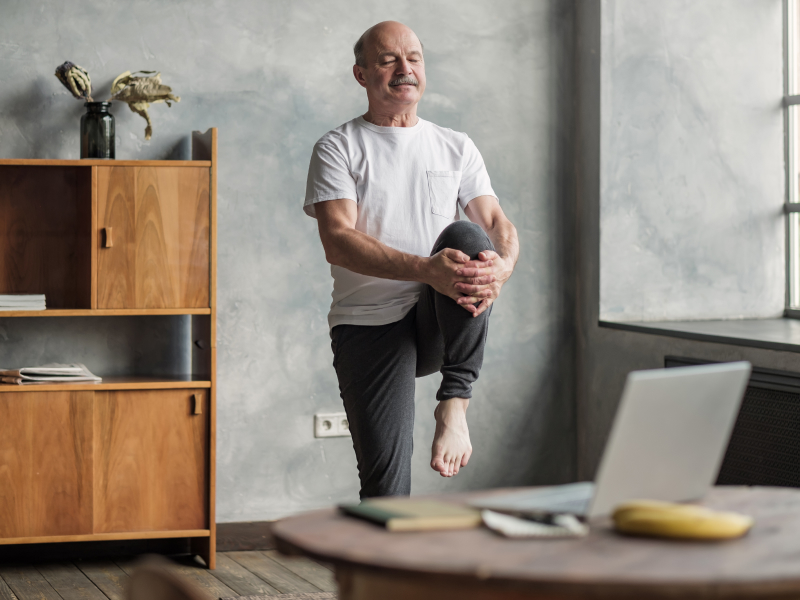
Static Stretches: Good to do every day to improve your balance and increase your flexibility. If you feel tight or stiff, or like the relaxation of stretching, incorporate static stretching daily to increase your functional range of motion. Here’s a yin routine to do daily, and a yang post-game static routine to relax the body after playing.
2. Hydrate. Hydrate. Hydrate.
Don’t get dehydrated when you play, so invest in a great water bottle and keep it filled. And keep drinking fresh water before, during, and after your game time.

Before…
Before playing you want to be sweating a little from your dynamic stretch, so hydrate to replace body fluids you’re losing from sweat.
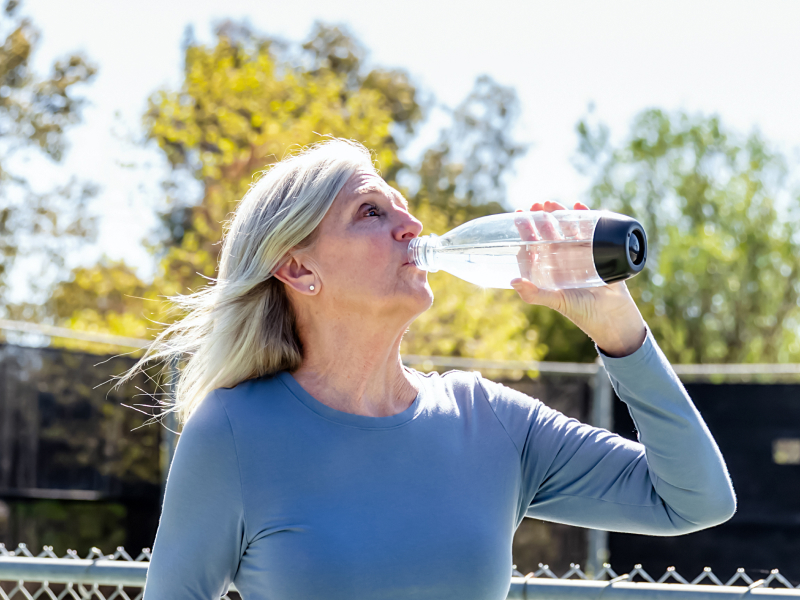
During…
Bring a water bottle with you onto the court and take frequent sips. Drink 7–10 ounces of water every 10–20 minutes between games.
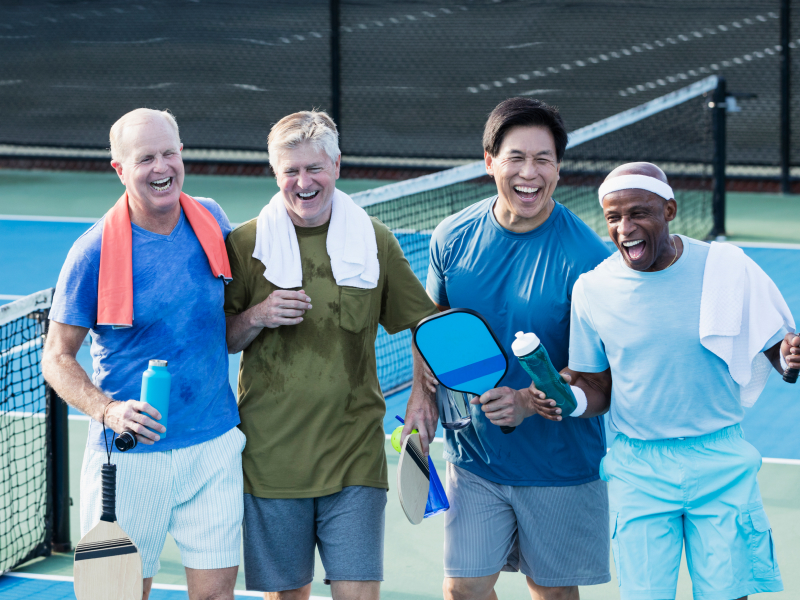
After…
To help your body cool down and aid in recovery, drink 8 ounces of water within 30 minutes after playing. Add another 20 ounces in the next two hours to avoid fatigue and cramps.
3. Good Form Isn’t Just for Winning Games
Practicing good form is HUGE when it comes to protecting yourself on the court. Here are some “Dr. Wood Pickleball Tips” that have a big impact on keeping your body from potential injury.
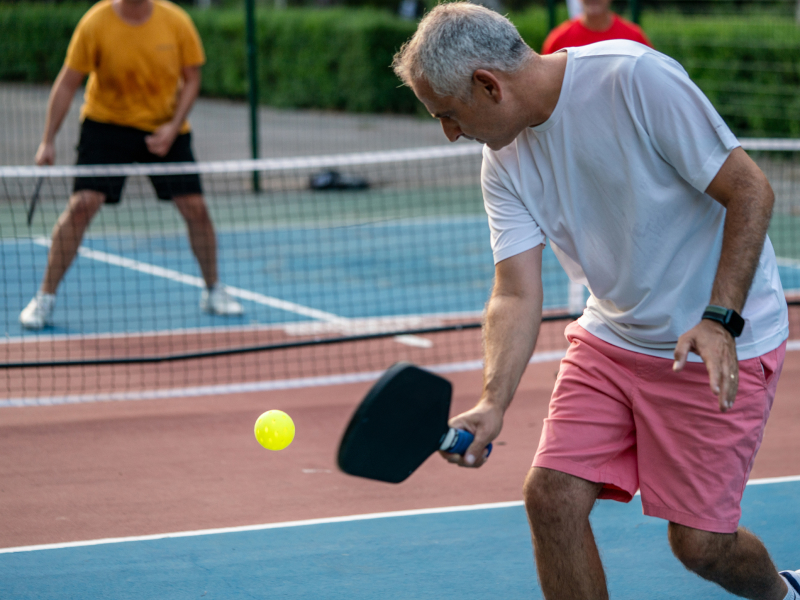
Practicing good form is HUGE when it comes to protecting yourself on the court. Here are some “Dr. Wood Pickleball Tips” that have a big impact on keeping your body from potential injury.
- To reduce chance of shoulder injury: Avoid overhead returns as much as possible, as sudden or extreme reaching up to return the ball can cause a tear in the rotator cuff.
- To lessen chance of wrist injury: Learn proper technique to hold your paddle and return the ball by holding the paddle below your waist. Some people like to play with a wrist brace, as twisting the wrist when holding the paddle can cause micro-injuries or tiny tears to the forearm tendons. And when your wrists are sore, it’s a good idea to ice down wrists after playing.
- To minimize leg cramps and pains: If hamstrings are not properly warmed up, large strides or sudden moves can strain or tear quadriceps muscles. So, go pack up to #1 and stretch, stretch, stretch both before and after your pickleball matches.
- Avoid falling, which can lead to fractures: Train your brain to apply some strategy. Rapid movements, sudden changes in direction, and running backward can cause falls. It’s way better to lose a point than fracture a wrist. Falls are much worse when you use your hands to break your fall—so practice working on your balance and reaction time at home to prevent falls.
4. Lifestyle Changes: Become More than a Weekend Warrior
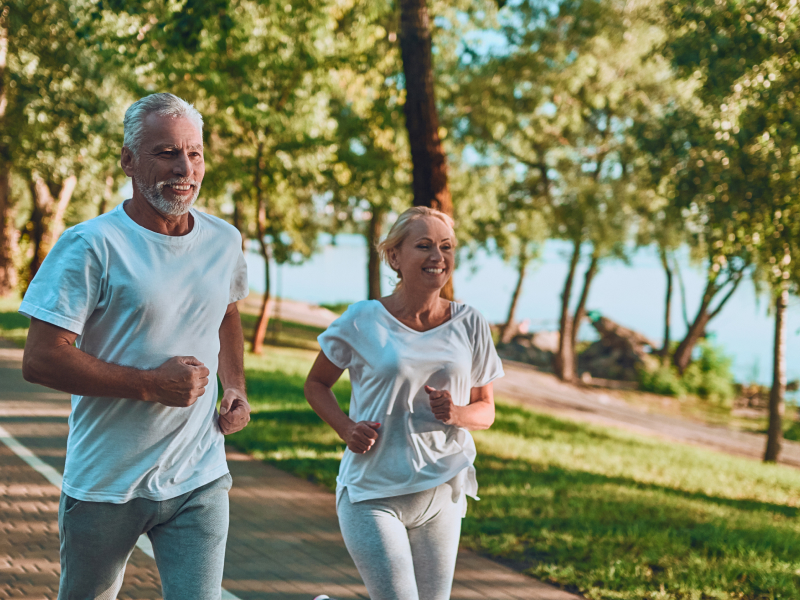
Cross-training is a way to help prevent injury.9 Pickleball is a low-impact aerobic exercise that’s also a cardio workout. If you have been sedentary and your cardio level is not that great, train up before you hit the court.
Cross-training and cardio exercises that can help with your pickleball training include:
- Jogging: This can help to increase your stamina and cardiovascular health.
- Cycling: Low-impact exercise that focuses on leg muscles, used a lot in pickleball. But stationary cycling or bicycling gives you a break from the impact of running on court.
- Interval training: 2X a week, alternate 30-second sprints with 30–60-second breaks.
- Yoga or Pilates: Both are tried-and-true methods for improving flexibility and balance. Again, start of slow and steadily increase your practice as your strength improves.
When on the court, go slow and gradually increase how much you play and the pace of play. Same goes for your daily exercise routine, start off slow and gradually add more exercise. Also, be sure to devote days of the week to rest with no play at all, so you’re not overdoing activity or creating situations for repetitive stress injuries.
5. Get the support you deserve
In general, I advise that patients stay active in life. Cross-training not only helps you to be stronger for the game, but it helps prevent injury – because you’ll gain improved balance, stamina, strength, and resilience. But if something hurts, don’t play through it. Take a break, rest, treat mild elbow or knee pain with ice, and if pain lingers, come see me. We’ll make sure nothing more significant is happening and help you heal more quickly when possible. Especially with ongoing joint pain, PRP injections can help speed your recovery.
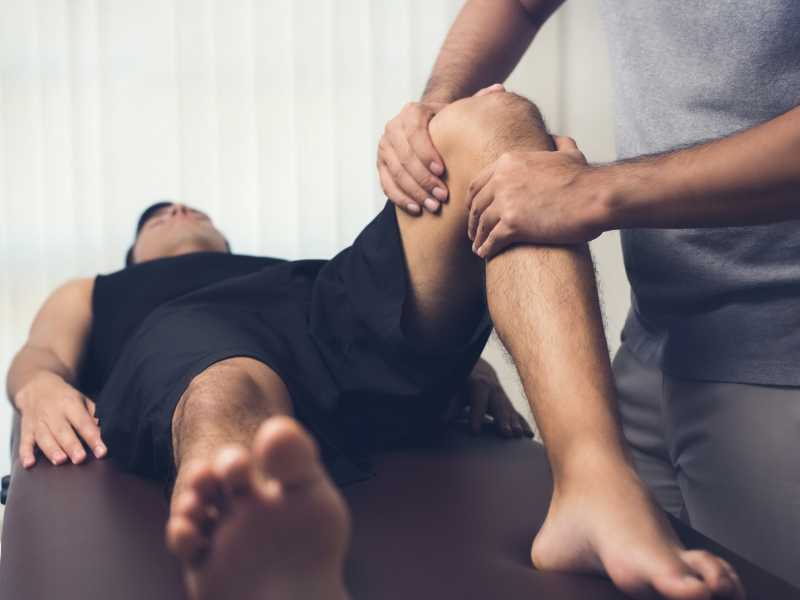
Whether you’re considering starting pickleball as a new sport, you’re a regular player, or you’re looking to up your game, stay in touch. Contact us to set up a consultation. Let’s keep you healthy so you can enjoy the social, physical, and mental advantages of playing with friends as long as possible.
Footnotes
- How to Prevent Pickleball Injuries ↩︎
- The Pickleball Player: Popularity Statistics & Demographics ↩︎
- Treating Geriatric Sports Injury Among Pickleball Players ↩︎
- Mayo Clinic, Symptoms of Tennis Elbow ↩︎
- Medical News Today: Can you have flare-ups of osteoarthritis? ↩︎
- “Talking with Docs” Pickleball: Most Common Injuries ↩︎
- Treating Geriatric Sports Injury Among Pickleball Players ↩︎
- How Active Are Older Americans ↩︎
- How Do You Cross-Train for Pickleball? 5 Exercises ↩︎
NW Regen
We offer regenerative and interventional medicine – tailored to empower you with a more vibrant, active lifestyle.


